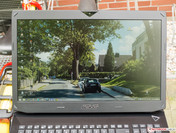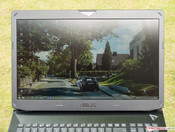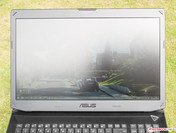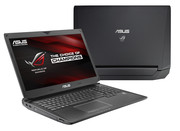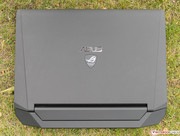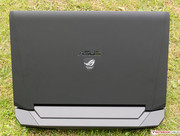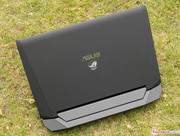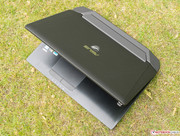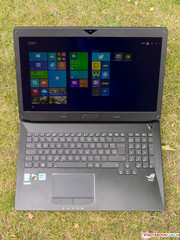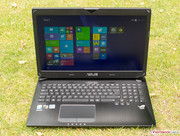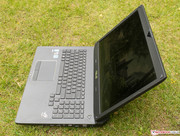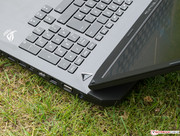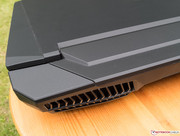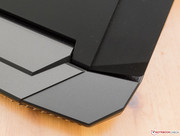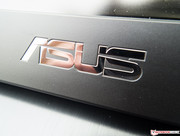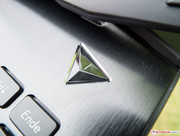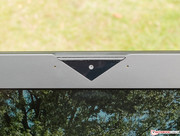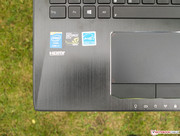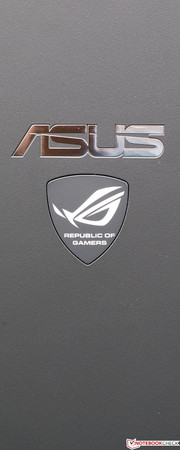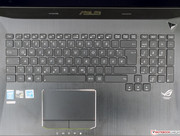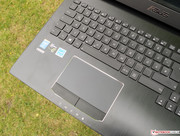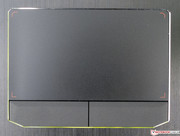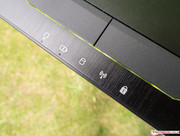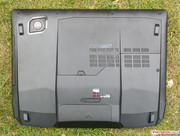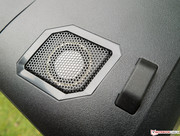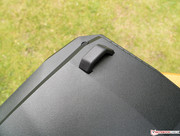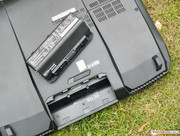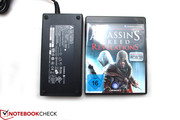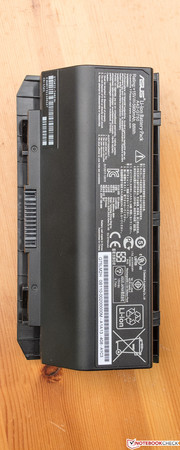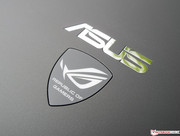Review Asus G750JZ-T4023H Notebook

For the original German review, see here.
The successor of Asus G750JH is very similar in terms of casing and innards, except for the older yet virtually identical Nvidia GeForce GTX 780M graphics card. It is available in different configurations. However, the casing, motherboard and interfaces, just like the Intel Core i7-4700HQ (4x 2.4 - 3.4 GHz, Hyperthreading, TDP: 47 W) and Nvidia's GeForce GTX 880M with a 4 GB GDDR5 RAM, are always the same. The buyer can opt between 8 and 16 GB of working memory, and Windows 8.1 or Windows 8.1 Pro. Additionally, there are various combinations of storage devices with or without (RAID) SSD, and wireless modules with or without "Gigabit Wi-Fi" available. Other screens or batteries are not offered.
We selected two, just as new, gaming machines with Full HD matte screens based on TN, and that sport the same GPU as the G750JZ but slightly faster CPUs for comparison. The first contender is the Schenker XMG P704 with an i7-4910MQ (2x 2.9 - 3.9 GHz, Hyperthreading, TDP: 47 W) and 16 GB of working memory. It is approximately 300 grams (~0.7 pounds) lighter and roughly 800 Euros (~$1098) more expensive than the Asus in late March this year. The second contender is the MSI GT70 2PE-890US that sports Intel's Core i7-4800MQ (4x 2.7 - 3.7 GHz, Hyperthreading, TDP: 47 W) alongside 12 GB of RAM. It is the only device that does not have an SSD and it weighs approximately 100 grams (~0.2 pounds) less than the Schenker. MSI sells its machine for just less than 1900 Euros (~$2607).
In addition to power, particularly the cooling and noise development of such high-performance laptops during games is interesting. Our report reveals how the Asus newcomer fares based on many measurements and benchmarks.
Case
4.3 kg (~9.5 pounds) is quite a weight, and the G750JZ's casing is correspondingly bulky. Asus stays true to itself in design. It looks like a typical Republic of Gamers laptop in a racy, futuristic design that slightly resembles an Italian racing car from the 1980s or even a Stealth Fighter. The completely black review sample could be the G750JH's identical twin. The base's upper side features a fingerprint-sensitive, brushed metal finish, and the bottom tray is composed of structured, non-slip plastic. The display bezel, back of the lid, and the area around the hinge have a velvety-soft feel. Fingerprints are not as obvious on these surfaces.
A recess for the battery is found in the rear's center. Two large vents are on its right and left. The left discharges the CPU's waste heat while the right one is responsible for the GPU. Thus, nothing has been modified here. The used materials make a high-quality impression; we did not find any obvious faults in build. The lid can be opened with one hand up to an angle of approximately 135°.
Connectivity
Asus uses the generous room available completely and adds a future-proof and universal Thunderbolt interface to the standard ports. Four USB 3.0 ports are impressive. The left side is appealing because two USB 3.0 ports have been ergonomically placed at the back where connected sticks and cords do not interfere. In return, the ports are concentrated in the middle to rear area on the right. Generally, everything that is desirable for most gamers is available.
Communication
As to Wi-Fi, Asus relies on the Bigfoot Networks Killer Wireless-N 1202 from Qualcomm, which should ensure very low latencies during online gaming. It also incorporates Bluetooth 4.0. It did a slightly above average job in overcoming an increasing distance and structural obstacles in the author’s personal test setup. There should not be any problems in practical use.
Accessories
Power supply, warranty documents, safety instructions, cable ties, and a hardware manual is all that is found. Media is not included. More accessories with the ROG logo can be found in Asus' online shop.
Maintenance
The maintenance cover only conceals the RAM banks, HDD, and SSD. The CPU, fans, and other components can only be accessed by disassembling the entire device because the tray is one piece, and that would likely void the warranty.
Warranty
In addition to the two-year limited retailer’s warranty, Asus includes a pick-up & return service in Germany and Austria for the same period. The international warranty can be upgraded to three years via the optionally available Asus Warranty Extension Package.
Input Devices
Keyboard
Disregarding the fact that the Z key in our sample of Asus' G750JZ was defective and could only be used with effort, the keyboard made a very good impression. The agreeably long drop, crisp pressure point, and slightly spongy stroke contribute to that. The keys are all in the usual place and generally feature the size known from standard desktop keyboards. Asus largely adopts this layout. Fast and quiet typing is possible, although that is only true to an extent for the larger keys. The keys are quite even and lightly rubber coated. The keyboard yields slightly, particularly in the center under high pressure. The homogeneous illumination and sufficient brightness of the three-level keyboard light also reaps in a good score from us.
Touchpad
We liked the gigantic touchpad's surface with its lightly roughened surface even more than the keyboard, though it is not quite sensitive up to the edges. Double clicking was detected just as reliably as a long left mouse click. Many devices fail in this point. Maneuvers, such as drag and drop, never aggravated the tester either. The well-conceived input is rounded off by its two physically separated keys that feature a clearly palpable yet quiet feedback, and which are very pleasant to use. Many detailed setting options (Asus Smart Gesture, see screenshot below) should fulfill all wishes.
Display
Asus uses a fairly high-quality, razor-sharp, and matte TN screen with a Full HD resolution (16:9) for its gaming machine. It might make sense for the target group due to the screen's higher responsiveness in contrast to most IPS displays. Both comparison devices are equipped with this feature for the same reason. A major drawback of TN technology is that the viewing angles are usually limited, but more about that below.
The average brightness of 258 cd/m² is not high for a laptop from this price range. Schenker's device achieves a very good 308 cd/m², and MSI's machine still reaches 302 cd/m². However, this should not be an issue since outdoor gaming will unlikely be the rule, and we even reduced the brightness indoors. The illumination of 80% is not a top rate either, but we did not notice problems like screen bleeding, etc.
| |||||||||||||||||||||||||
Brightness Distribution: 80 %
Center on Battery: 275 cd/m²
Contrast: 561:1 (Black: 0.49 cd/m²)
ΔE ColorChecker Calman: 3.34 | ∀{0.5-29.43 Ø4.79}
ΔE Greyscale Calman: 2.2 | ∀{0.09-98 Ø5}
58% AdobeRGB 1998 (Argyll 1.6.3 3D)
64.8% AdobeRGB 1998 (Argyll 3D)
88.6% sRGB (Argyll 3D)
67.9% Display P3 (Argyll 3D)
Gamma: 2.5
CCT: 6654 K
The black level of Asus G750JZ is decent with 0.49 cd/m², although both Schenker's and MSI's laptops are slightly better here. Black looks very saturated (RGB: 0,0,0). The contrast reflects the maximum relative brightness differences, and can be ascertained from the black level and brightness. Since these two rates are not breathtaking, the contrast ratio of 561:1 is not either. The ratio of both contenders in the test was approximately 1000:1, which is a very good result.
Schenker's XMG and MSI GT70 are both hopelessly inferior when it comes to color accuracy. The review sample already excels right after unboxing, i.e. without calibration, with low DeltaE rates of just 2 (Grayscale) and 3 (ColorChecker), untypical especially for TN screens. Both other laptops exhibit a DeltaE of over 10, and thus are very remote from the ideal, which is seen in a bluish cast as usual. That is logically not seen in Asus' laptop. The G750JZ just manages to win the last challenge in color gamut that is only important for (semi-) professional image editors. 58% of the large AdobeRGB color space is a great rate for a TN screen that can compete with most IPS screens.
As usual, the weather and positioning are the main factors for the likely rare use outdoors. The matte screen enables working outdoors in the shade and on cloudy days when the skies do not have light gaps. Barely anything can be recognized in direct sunlight.
As indicated above, frugality will not have been the decisive factor for choosing a TN screen. In terms of viewing angles, the AU Optronics screen does a fairly good job. It proves to have a considerably higher tolerance than the budget screens that are frequently found in multimedia laptops from the 600 Euro (~$823) price range. This is very evident when altering the horizontal viewing angle, where the usual brightness and contrast losses first occur in very slight angles and to a relatively moderate extent.
Performance
Our G750ZJ is a gaming laptop from Asus' well-known Republic of Gamers product line designed for high performance. Intel's Core i7-4700HQ quad-core can make use of an 8 GB working memory, and the premium range Nvidia GeForce GTX 880M GPU with 4 GB of dedicated GDDR5 RAM provide enough power for all thinkable application scenarios. Even the most computing intensive and highly parallelized programs, such as 3ds Max 3D rendering software, do not overburden the device. Naturally, portability aspects like weight and compactness come up short, and no business-suitable security features will be found.
Processor
The Core i7-4700HQ is a member of Intel's current Haswell generation, and is built in the 22 nm process. It features four physical cores that can process up to eight threads simultaneously owing to Hyperthreading. The clock rates range from 2.4 to 3.4 GHz and the TDP is specified with 47 Watts. The limit is 3.2 GHz when all cores are loaded and 3.3 GHz when two cores are loaded. Although Intel offers a few slightly faster mobile CPUs, such as the i7-4940MX top model (4x 3.1 - 4 GHz, Hyperthreading, TDP: 57 Watts), the i7-4700HQ is one of the US chip giant's current premium models, and thus also suitable for the most demanding tasks. The relatively high TDP makes the CPU recommendable for use in large laptops with a screen size of 15.6 inches and more.
Asus' G750JZ achieved the expected top rate of 6.93 points in the Cinebench R11.5 multi-CPU benchmark. The G750JH precursor with the same CPU reached a similar score. Schenker's XMG surpasses the review sample by 9% owing to its Intel Core i7-4910MQ (4x 2.9 - 3.9 GHz, TDP: 47 W), and MSI's GT70 with an Intel Core i7-4800MQ (4x 2.7 - 3.7 GHz, TDP: 47 W) by 8%. This advantage is insignificant for practical use. The latest Cinebench R15 confirms these findings.
The review sample cannot maintain the specified full-load clock rate of 3.2 GHz when all cores are stressed via Prime95. It ranges from 3.0 to 3.1 GHz, which is not ideal, but not unusual either. The one-core Turbo of 3.4 GHz will only be rarely achieved anyway. The G750JZ also achieves this performance level in battery mode.
| Cinebench R11.5 | |
| CPU Multi 64Bit (sort by value) | |
| Asus G750JZ-T4023H | |
| Schenker XMG P704 | |
| MSI GT70 2PE-890US | |
| Asus G750JH-T4080H | |
| CPU Single 64Bit (sort by value) | |
| Asus G750JZ-T4023H | |
| Schenker XMG P704 | |
| MSI GT70 2PE-890US | |
| Asus G750JH-T4080H | |
System Performance
Besides the CPU and GPU, the storage devices play a role when assessing the system performance. PCMark 7 basically reflects the same proportional differences between the three contenders as the Cinebench tests. That is not surprising when considering that all sport the same GPU. MSI is an exception due to the conventional HDD's considerably lower performance, which cannot at all match the (RAID) SSDs of both other laptops. We would subjectively describe the performance in routine use as extremely swift.
| PCMark 7 Score | 5746 points | |
| PCMark 8 Home Score Accelerated v2 | 3260 points | |
| PCMark 8 Creative Score Accelerated v2 | 5153 points | |
| PCMark 8 Work Score Accelerated v2 | 4271 points | |
Help | ||
Storage Devices
Asus decided to place the operating system and another, 128 GB partition on a RAID 0 array comprised of two single 128 GB SSDs (SanDisk X110). That perhaps sounds good in the marketing brochure, but we have doubts about the usefulness of this design. It does not improve data security, and increases power consumption and weight. The extremely increased transfer rate in sequential read will likely only be noticed in very large files in real-life use compared with standard-configured SSDs. 4k access times generally do not benefit from SSD RAIDs, as the measurements confirm. At most, the better performance in reading small, random data blocks using multiple threads simultaneously could improve the perceived speed in some cases even further.
| Asus G750JZ-T4023H GeForce GTX 880M, 4700HQ, 2x Sandisk X110 SD6SP1M-128G RAID 0 | Schenker XMG P704 GeForce GTX 880M, 4910MQ, Crucial M500 480 GB CT480M500SSD3 mSATA | MSI GT70 2PE-890US GeForce GTX 880M, 4800MQ, HGST Travelstar 7K1000 HTS721010A9E630 | Asus G750JH-T4080H GeForce GTX 780M, 4700HQ, Liteonit LMT-256M6S | |
|---|---|---|---|---|
| AS SSD | -23% | -23% | ||
| Seq Read (MB/s) | 811 | 482.2 -41% | 493.4 -39% | |
| 4K Read (MB/s) | 26.74 | 26.52 -1% | 29.32 10% | |
| 4K-64 Read (MB/s) | 499.7 | 319.2 -36% | 331.3 -34% | |
| Score Read (Points) | 608 | 394 -35% | 410 -33% | |
| Score Write (Points) | 428 | 409 -4% | 355 -17% | |
| CrystalDiskMark 3.0 | -22% | -95% | -16% | |
| Read Seq (MB/s) | 815 | 476.5 -42% | 123.6 -85% | 503 -38% |
| Read 4k (MB/s) | 30.04 | 29.13 -3% | 0.4 -99% | 31.71 6% |
| Read 4k QD32 (MB/s) | 431 | 339.4 -21% | 0.748 -100% | 362.2 -16% |
| Total Average (Program / Settings) | -23% /
-23% | -95% /
-95% | -20% /
-20% |
Graphics Card
Nvidia provides the currently fastest mobile (single) GPU on the market with its GeForce GTX 880M released in March 2014. Like the precursor GeForce GTX 780M, the GK104 chip with 1536 Shader units is based on the Kepler architecture, but it has an approximately 15% higher base clock of 954 MHz. Our review sample achieved a plus of 30 MHz owing to the automatic overclocking (Asus GPU Tweak). The review sample's speed can be increased up to 993 or 1023 MHz via Boost. The chip features a dedicated graphics memory of 4 GB with an effective clock of 5 GHz.
As expected, the performance is very high. The three 880M-based devices are very close in the graphic-heavy benchmarks of 3DMark (2013) and 3DMark 11 (i.e. not Score and Physics). Based on the otherwise very similar configuration, including the identical CPU, the performance leap of the new GTX 880M compared with the GTX 780M in the G750JH can be nicely observed. It ranges from 13 to 19%, depending on the graphics test. The familiar power relation of the CPUs again becomes evident in the total scores and Physics tests. The 3D performance drops massively in battery mode because the cell does not have enough current.
| Asus G750JZ-T4023H GeForce GTX 880M, 4700HQ, 2x Sandisk X110 SD6SP1M-128G RAID 0 | Schenker XMG P704 GeForce GTX 880M, 4910MQ, Crucial M500 480 GB CT480M500SSD3 mSATA | MSI GT70 2PE-890US GeForce GTX 880M, 4800MQ, HGST Travelstar 7K1000 HTS721010A9E630 | Asus G750JH-T4080H GeForce GTX 780M, 4700HQ, Liteonit LMT-256M6S | |
|---|---|---|---|---|
| 3DMark | 2% | 3% | -11% | |
| 1920x1080 Fire Strike Graphics (Points) | 6251 | 6095 -2% | 6197 -1% | 5171 -17% |
| 1920x1080 Fire Strike Score (Points) | 5574 | 5493 -1% | 5577 0% | 4679 -16% |
| 1920x1080 Fire Strike Physics (Points) | 8848 | 9775 10% | 9754 10% | 8956 1% |
| 3DMark 11 | 7% | -2% | -9% | |
| 1280x720 Performance GPU (Points) | 9003 | 8690 -3% | 8614 -4% | 7279 -19% |
| 1280x720 Performance (Points) | 8418 | 8514 1% | 8148 -3% | 7159 -15% |
| 1280x720 Performance Physics (Points) | 7102 | 8706 23% | 7230 2% | 7586 7% |
| Total Average (Program / Settings) | 5% /
5% | 1% /
1% | -10% /
-10% |
| 3DMark 11 Performance | 8418 points | |
| 3DMark Cloud Gate Standard Score | 18412 points | |
| 3DMark Fire Strike Score | 5574 points | |
Help | ||
Gaming Performance
We would like to refer to our page about the GeForce GTX 880M that features many synthetic and gaming benchmarks, for example the latest graphic sensations like Assassin's Creed Black Flag. Except for X-Plane 10.25 and the extremely hardware-devouring Company of Heroes 2, the frame rate never falls below the magical boundary of 30 fps even when using Full HD and ultra settings. It is considerably higher in many new and graphically demanding tracks. That proves that there are enough reserves for anti-aliasing, tessellation, and other similar features for the foreseeable future. A brief comparison of the laptop used in this review can be found below the verdict.
| low | med. | high | ultra | |
|---|---|---|---|---|
| Total War: Shogun 2 (2011) | 220.8 | 106.7 | 73 | |
| Batman: Arkham City (2011) | 228 | 205 | 136 | 94 |
| Dishonored (2012) | 129.2 | 128.8 | 128.9 | 127.4 |
| Medal of Honor: Warfighter (2012) | 170.4 | 147.9 | 137.4 | 59.5 |
| Call of Duty: Black Ops 2 (2012) | 218.9 | 204.5 | 156.5 | 105.2 |
| Hitman: Absolution (2012) | 58 | 54.9 | 47.9 | 36.9 |
| BioShock Infinite (2013) | 189.2 | 158.5 | 151 | 65.8 |
| Company of Heroes 2 (2013) | 56.8 | 54.3 | 46.51 | 24.36 |
| Thief (2014) | 55.7 | 54.5 | 53.5 | 40.3 |
Emissions
System Noise
Now we compare the noise levels, and look first at the load states. Asus has done a good job here because both contenders achieve an approximately 13% higher dB(A) rate. For information: The measured noise level does not consider any psychoacoustic factors, i.e. the subjective noise level does not scale proportionally to the dB(A) rate. As a rule, the loudness is subjectively perceived as roughly twice as high when increasing the level by 10 dB(A). Thus, the differences are greater than the raw figures suggest. Asus' G750JZ barely places itself in the upper third of the field in medium load (load average) when compared with current gaming laptops.
We would subjectively describe the fans as harnessed, dynamic, and without irregular speed levels. They are often disabled when idle. However, just a light load makes them audible, though not distracting. Gaming causes a clear, mid-frequency noise that was unfortunately associated with minor whistling noises. Nevertheless, we did not perceive the noise development as annoying in the course of the test. The hard drive was not discernible.
| Asus G750JZ-T4023H GeForce GTX 880M, 4700HQ, 2x Sandisk X110 SD6SP1M-128G RAID 0 | Schenker XMG P704 GeForce GTX 880M, 4910MQ, Crucial M500 480 GB CT480M500SSD3 mSATA | MSI GT70 2PE-890US GeForce GTX 880M, 4800MQ, HGST Travelstar 7K1000 HTS721010A9E630 | |
|---|---|---|---|
| Noise | -12% | -12% | |
| Idle Minimum * (dB) | 29.6 | 34.1 -15% | 34.2 -16% |
| Idle Average * (dB) | 31.2 | 35 -12% | 34.4 -10% |
| Idle Maximum * (dB) | 33.8 | 36.6 -8% | 34.8 -3% |
| Load Average * (dB) | 41.1 | 48.2 -17% | 46.8 -14% |
| Load Maximum * (dB) | 48.8 | 52.4 -7% | 56 -15% |
* ... smaller is better
Noise level
| Idle |
| 29.6 / 31.2 / 33.8 dB(A) |
| HDD |
| 31.2 dB(A) |
| DVD |
| 38.2 / dB(A) |
| Load |
| 41.1 / 48.8 dB(A) |
 | ||
30 dB silent 40 dB(A) audible 50 dB(A) loud |
||
min: | ||
Temperature
Our Asus machine never surpassed an idle temperature of 30 °C (86 °F); the warmest spot we found during load was 44 °C (111.2 °F) in the area of the GPU's vent on the underside. The upper side never exceeded 34 °C (93.2 °F) even during gaming, which is approximately 25% less than both Schenker's and MSI's laptops. Overall, we have to confirm that the manufacturer has the temperatures well under control despite the brute performance, but the bulky casing also contributes to that. The temperatures of maximum 72 °C (161.6 °F) (CPU) and 77 °C (170.6 °F) (GPU) remain within the specified limits.
(+) The maximum temperature on the upper side is 34.2 °C / 94 F, compared to the average of 40.5 °C / 105 F, ranging from 21.2 to 68.8 °C for the class Gaming.
(±) The bottom heats up to a maximum of 44 °C / 111 F, compared to the average of 43.3 °C / 110 F
(+) In idle usage, the average temperature for the upper side is 27.7 °C / 82 F, compared to the device average of 33.9 °C / 93 F.
(+) The palmrests and touchpad are cooler than skin temperature with a maximum of 26.6 °C / 79.9 F and are therefore cool to the touch.
(+) The average temperature of the palmrest area of similar devices was 28.9 °C / 84 F (+2.3 °C / 4.1 F).
Speakers
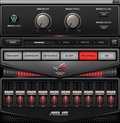
We tested the G750JZ's sound on a table that served as a resounding surface for the subwoofer, and played the usual music tracks and Crysis 3 that was praised for its sound. The ROG AudioWizard based on Maxxaudio is preinstalled. Besides a few presets, such as "Battlefield" that we used for Crysis 3, detailed options like an equalizer are available in the extended mode (screenshot). The device renders quite natural-sounding music with a high volume and a differentiated, balanced, dynamic sound that even has some bass when all tweaks are disabled. Asus' laptop clearly gains (too much) volume and dominance when Maxxvolume is enabled. The tendency to a rather hard tuning is clearly intensified, and distortions occur in maximum volume in some places. Linear setting may be better suitable for music, but the sound in Crysis 3 was throughout impressive, and the atmosphere definitely benefited from the software enhancements. The sound was of a high standard expected from modern onboard audio chips over the sound system at home. However, it cannot match that of an X-Fi card from Creative, for example.
Energy Management
Power Consumption
Low power consumption will unlikely be the center of attention for potential buyers of Asus' G750JZ, but looking never hurts. 0.1 Watts when turned off is not worth mentioning, but not necessary either. A standby consumption of 0.4 Watts is a good average compared with other 17.3-inch gaming laptops. The consumption while idling is still within the upper third of this field (avg., max.). No big differences to MSI's laptop were recorded. However, Schenker's device proved to be a guzzler with a plus of 38 to 76%. The load averages are; Asus 115 Watts, Schenker 140 Watts, MSI 128 Watts. Both Asus' and Schenker's machine consume approximately 215 Watts from the outlet in maximum load, while MSI is satisfied with 182 Watts despite similar gear. For comparison: SLI systems based on two GTX 880Ms, such as Schenker's XMG P724, consume up to 326 Watts, which is an exorbitantly high rate.
| Off / Standby | |
| Idle | |
| Load |
|
Key:
min: | |
Battery Runtime
Users who want to use their G750JZ on the go will be pleased to hear that the battery runtime in the practical Wi-Fi test belongs to the Top 3 of comparable laptops with almost six and a half hours. MSI's GT70 surpasses that by only twelve minutes. We did not assess the load runtimes since decent gaming without a power supply is not possible. One of the longest movies of all times is likely "Gone with the Wind" at 236 minutes. The review sample just managed that when played from a DVD.
Verdict
Asus launches a particularly balanced and well-designed gaming laptop with its latest incarnation of the well-known ROG series dubbed G750JZ. Despite its extreme computing and graphic power, the machine does not exhibit weaknesses in temperature or sound, and is superior to both comparison devices. Though both contenders sport a slightly stronger CPU, this leads to only a marginal performance increase because the GPU is the limiting factor in games. In real-life use, this extra power is irrelevant in view of the extremely high overall standard. It is a fact that the few games that push the Asus close to its limits in ultra settings can be counted on the fingers of one hand - and they only benefit minimally if at all from slightly faster processors.
In our opinion, there is nothing that would contest the steep price. The excellent, rich color screen is surely not an IPS with sensational viewing angle stability, but hardcore gamers will be grateful to Asus and they will also be pleased about the fast switching times. The good input devices, decent connectivity, and the quiet and sometimes even silent fan when idle also predestine the G750JZ as a high-performance desktop replacement for working, browsing, and multimedia.
We cannot think of many arguments for Schenker's or MSI's devices when we compare all devices. The XMG P704 offers a modular concept with diverse expansion options, but is also louder, far pricier, and left us with a doubtful impression in terms of design. "Extremely loud during full load" was one verdict in our review of MSI's GT70, alongside the too small touchpad. However, we praised its sound. Besides that, it is the lightest and least expensive laptop in the test. Buyers who are satisfied with "second-best" might find a bargain in Asus' G750JH precursor since its price will quickly drop due to its successor.
| Hitman: Absolution - 1920x1080 Ultra Preset AA:4xMS AF:16x (sort by value) | |
| Asus G750JZ-T4023H | |
| Schenker XMG P704 | |
| BioShock Infinite - 1920x1080 Ultra Preset, DX11 (DDOF) (sort by value) | |
| Asus G750JZ-T4023H | |
| Schenker XMG P704 | |
| Company of Heroes 2 | |
| 1920x1080 Maximum / Higher / High AA:High (sort by value) | |
| Asus G750JZ-T4023H | |
| MSI GT70 2PE-890US | |
| Asus G750JH-T4080H | |
| 1366x768 High AA:Medium (sort by value) | |
| Asus G750JZ-T4023H | |
| MSI GT70 2PE-890US | |
| Asus G750JH-T4080H | |
| Thief | |
| 1920x1080 Very High Preset AA:FXAA & High SS AF:8x (sort by value) | |
| Asus G750JZ-T4023H | |
| Schenker XMG P704 | |
| 1366x768 High Preset AA:FXAA & Low SS AF:4x (sort by value) | |
| Asus G750JZ-T4023H | |
| Schenker XMG P704 | |
















